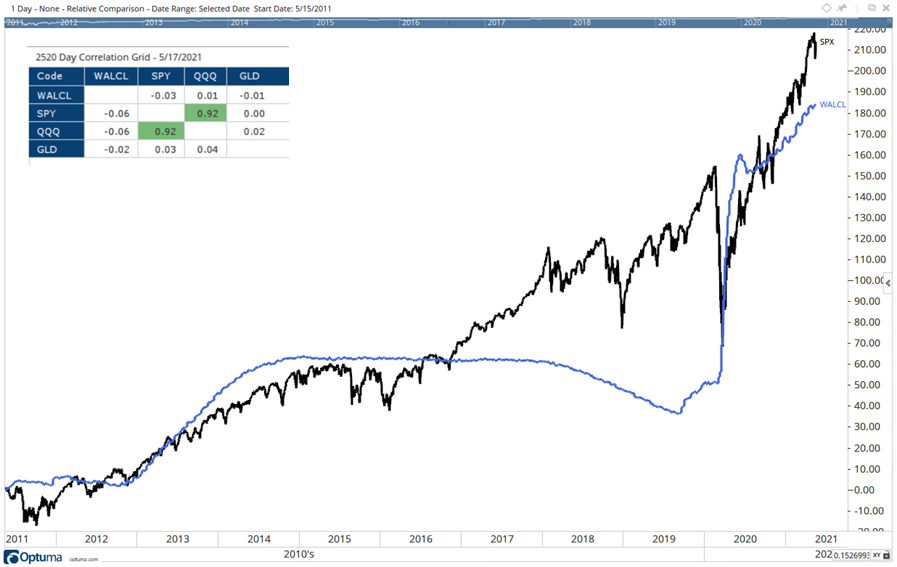Economists often say that the Federal Reserve can’t push on a string. This creates a visual image of a string on a table with someone trying to push the string and seeing no result for their efforts.
Historically, this saying meant that the Fed could find success pulling the economy out of a recession but would struggle to push the economy into a slowdown. This simple saying highlights the risks the Fed faces now.
News of inflation grows, but Fed officials insist that price pressures are transitory. This implies the Fed can slow the economy and influence prices, but data shows the Fed has limited ability to influence the economy.
To assess the Fed’s ability to influence economic activity, we can use the prices of stocks and gold. Stocks tend to track the economy in the long run. Gold tends to track inflation in the long run.
The chart below shows the relationship between the Fed’s balance sheet and the SPDR S&P 500 ETF (NYSE: SPY).
The small table in the upper right shows the correlation between the two data series. The table also shows the correlations for Invesco QQQ Trust (Nasdaq: QQQ) an ETF that tracks the Nasdaq 100 Index. QQQ has been a market leader over the past year. The correlation with SPDR Gold Shares (NYSE: GLD) is also shown.
The Fed’s Balance Sheet Affects Stocks

Source: Optuma.
The Fed’s Tightening Policy Could Depress Stocks
Correlations range from -1.0 to +1.0. Values near -1 or 1 show a strong mathematical relationship. Values near zero are essentially random. The correlations between the Fed’s balance sheet, SPY, QQQ and GLD are essentially random. This indicates the Fed doesn’t have much influence over the stock market or gold prices over the long run.
The chart does show that gains in the Fed’s balance sheet, a measure of how quickly the Fed is adding money to the economy, appear to move in the same direction. This reflects the fact that some of the money the Fed created moved into the stock market.
While there’s no tradable rule, the stock market will likely decline as the Fed tightens its policy and removes money from the economy. Traders who have seen the Fed increase its balance sheet for more than a decade will panic. In that way, the Fed will lower stock prices whether it intends to or not.
I’m not quitting anything…
I’m just showing people a new way to make money in the markets.
My typical approach targets setups in individual stocks. With roughly 3,000 U.S. stocks, there’s plenty of opportunity.
But my new approach has simplified everything and boiled the markets down to one repeatable trade in the same ticker symbol.
The annual return was 132% last year. Click here to see how we did it. And most importantly, how it could benefit you.
Michael Carr is a Chartered Market Technician for Banyan Hill Publishing and the Editor of One Trade, Peak Velocity Trader and Precision Profits. He teaches technical analysis and quantitative technical analysis at the New York Institute of Finance. Mr. Carr is also the former editor of the CMT Association newsletter, Technically Speaking.
Follow him on Twitter @MichaelCarrGuru.





